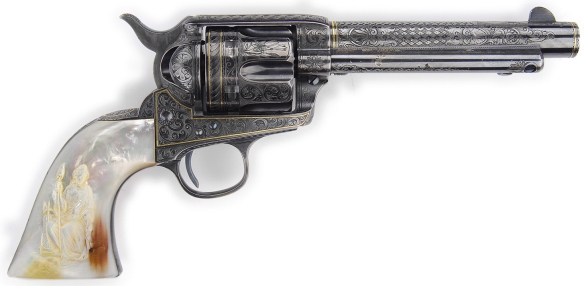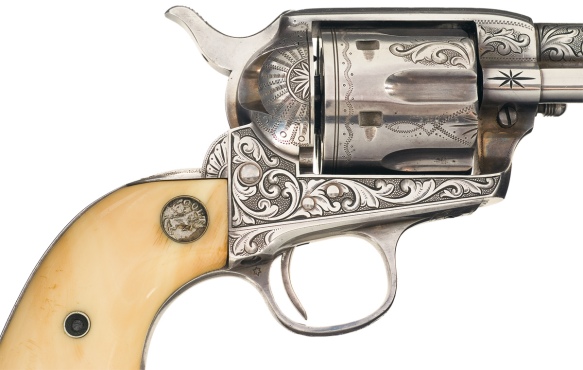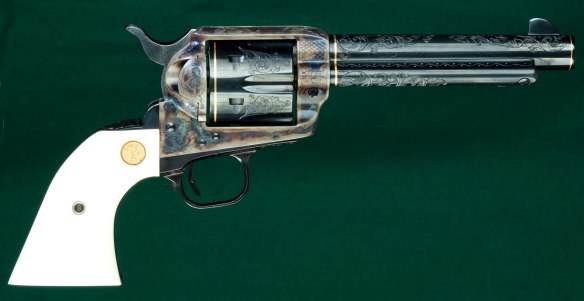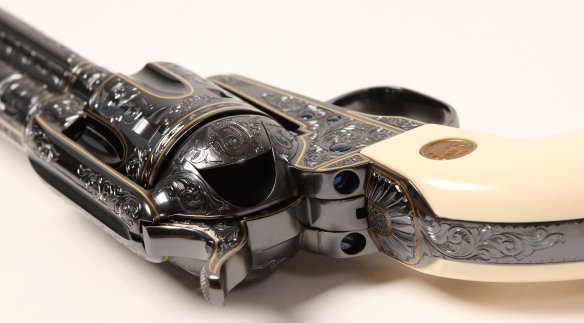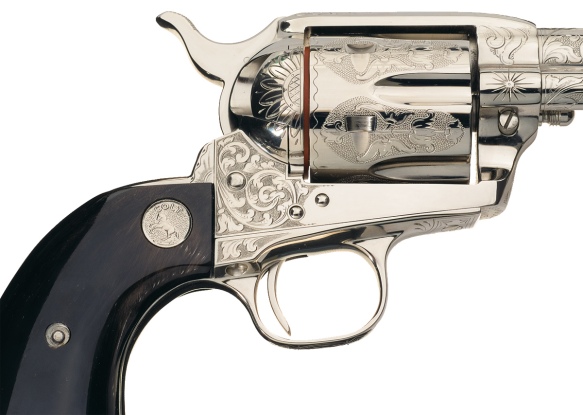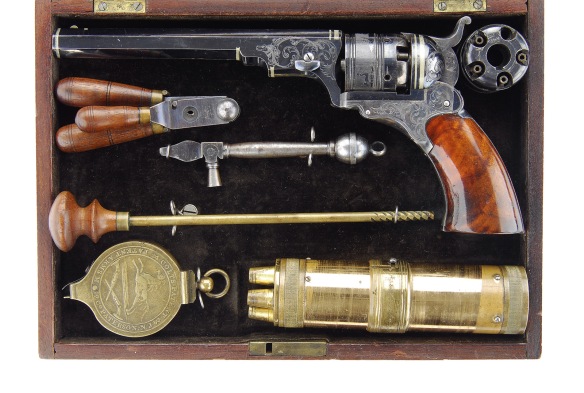Not so many decades ago, the taming of America’s “Wild West” was still only grist for history books yet unwritten. In today’s civilized, organized, regulated, and legalized society, it takes some imagination to visualize what life and “law and order” must have been like, back then. For better or for worse, one of America’s most recognizable icons has emerged from the turmoil of those Wild-West days to become embedded in our national consciousness.
The Colt Single Action Army (SAA) revolver is synonymous with the “Wild West” in the minds of Americans. It is virtually the only sidearm portrayed in the wildly popular, early western movies and television shows. Gene Autry, Roy Rogers, and Hopalong Cassidiy would not be caught dead without Colt SAA revolvers in their holsters…or maybe they would! The SAA was called “The Peacemaker” and for good reason – its ubiquitous presence in the holsters of frontier sheriffs who were duty-sworn to keep law and order in the “new territories” of our expanding nation.
I sincerely hope that readers who instinctively do not like guns will not stop reading, at this juncture. My interest in the iconic Colt SAA is purely historical and reflects no inclinations on my part to argue the pros and cons of firearms in today’s society. As you will soon appreciate, the story of Samuel Colt and his firearms company is an integral part of our country’s history and industrial heritage.
Surprisingly (to me, as well), there is an aesthetic case to be made for the Colt SAA which contributes to its iconic stature; I will explain. As with the automotive industry which blossomed precisely at the heyday of the Colt’s popularity, there were also plenty of would-be competitors in the firearms business, but, like the Model T Ford, only one sidearm would emerge an icon in its field…and that certainly was the Colt SAA revolver, usually in its storied .45 caliber.
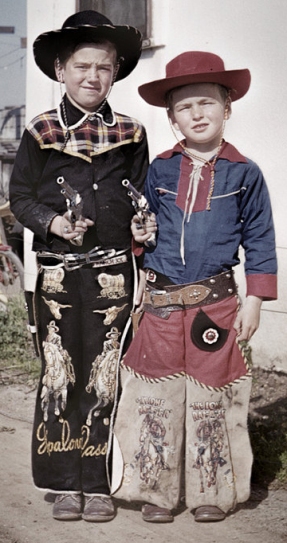 Millions of us senior males recall with great fondness playing “cowboy” in our early youth. Who among us does not recall the cheap, die-cast cap guns clearly modeled after the Colt SAA …and that distinctive, sharp gunpowder smell which emanated from firing a roll of caps through the pistol – at the bad guys. The good guys always won, of course, when it came to dealing with outlaws.
Millions of us senior males recall with great fondness playing “cowboy” in our early youth. Who among us does not recall the cheap, die-cast cap guns clearly modeled after the Colt SAA …and that distinctive, sharp gunpowder smell which emanated from firing a roll of caps through the pistol – at the bad guys. The good guys always won, of course, when it came to dealing with outlaws.
Of more concern, today, was our youthful perception of “cowboys and Indians.” In retrospect, it is not always so easy to separate the “good” guys from the “bad” guys on the Old West stage. Most of us, today, have no illusions concerning our history of the white man’s settling of the West – at the expense of native Americans. The romantic portrayals of “good and bad” in our media and in our national conscience were often cockeyed, and the notion of wild shoot-outs and impersonal killing with a firearm for the sake of entertainment were not the stuff of which to be proud now that we reflect on it. Human nature being what it is, and the entertainment industry being what it is, virtually everything about the western frontier was unduly romanticized and sanitized.
Colt sold huge numbers of its flagship gun, the Single Action Army revolver, for good reason. Often, a man’s revolver was the only protection available against the numerous ne’er-do-wells on the far fringes of the frontier. His gun had to be quick and reliable. Firing cartridge bullets (usually the heralded Colt .45 caliber), the Colt SAA provided incredible advantages over the old percussion cap and ball, black powder revolvers which preceded it for decades. Those were clumsy to reload and shoot and not nearly as accurate as the SAA.
The old black powder handguns were still the staple of soldiers in the U.S. Civil War, less than ten years prior to the 1873 introduction of the SAA. They were not only heavy and clumsy to reload and shoot, they were also decidedly homely looking weapons. Due to its ease of use, reliability, and accuracy, the 1873 Colt Peacemaker was a revelation to its new owner, those merits reflecting the most important considerations in choosing any sidearm…aside from the initial cost.
There is one other aspect of the Colt SAA that intrigues me and sets it even further apart from its nearest competitors, and that is its “beauty” – yes, I said beauty! Admittedly, handguns are generally ugly mechanisms, both in the emotional sense (for many) and in the physical sense. For me, the Colt SAA is a glaring exception which helps to explain its iconic status; its lines are classic and functionally straight-forward – even graceful.
There is virtually no other product I can think of whose physical image and functional usefulness has withstood the test of time …over many decades. Think of the Model T Ford compared to today’s sleek Ford Fusion, for example. Think of cameras, of telephones, and of airplanes – from the biplane to today’s sleek jet fighter aircraft. More than any other product that comes to mind, the Colt SAA maintains an aesthetic and functional appeal, very little diminished since its introduction in 1873. What other manufactured product can make that claim? The gun’s elegant, graceful lines reflect the straight-forward functionality of its design.
Holding a Colt in one’s hand makes it easy to appreciate the heft and balance of its machined and polished steel assembly. As it comes off the assembly and finishing lines, a Colt SAA revolver inherently reflects the artisan’s touch of a fine machinist, where precision and fit are paramount. With the addition of a master engraver’s imaginative artistry graved into its fine steel finish, a Colt SAA becomes an artistic work of great beauty as the following pictures amply prove.
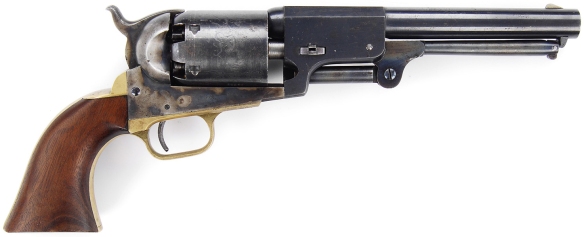 A Colt third model “Dragoon” black powder pistol – the rather clumsy forerunner of the classic Single Action Army, Colt .45 revolver.
A Colt third model “Dragoon” black powder pistol – the rather clumsy forerunner of the classic Single Action Army, Colt .45 revolver.
The Colt SAA illustrated at the very beginning of this post is the famed Sears and Roebuck “Cowboy Special” Single Action Army custom engraved at the Colt factory in the early nineteen-hundreds as a special order for Sears and Roebuck. The gun was fully engraved with fine gold line inlays and offered for sale in Sears’ renowned catalogue for a number of years as a marketing ploy – an attention-getter! The price must have been stiff, presumably to evoke comment, and the gun never sold after being offered for some years. Clearly, Sears had no intention to make money off its sale and wanted to keep it around for its publicity value.
The revolver was put into a vault long ago and lay forgotten for many years – until it was rediscovered in the mid nineteen-fifties. At that point, it was offered to the famous singer and ardent Colt collector, Mel Torme, for $750. After much deliberation over the “stiff price,” Torme purchased it. Several years ago that same gun was auctioned by the auction house, James D. Julia Auctioneers of Fairfield, Maine, for $747,500! They provided the picture of it used, here, as well as a few others in this post.
You now have some idea just how collectable Colt firearms can be, especially Colt factory engraved and inlaid SAA’s. Especially coveted are those done by the handful of recognized master engravers employed by Colt back in its heyday – true artists who often spent their entire careers at Colt. Factory engraved Colts by Gustave Young, L. D. Nimschke, and Cuno Helfricht are very highly sought.
The above cased presentation set containing an engraved No. 2 Colt Patterson percussion revolver and accessories was auctioned several years ago by James D. Julia Auctioneers, Fairfield, Maine – for the princely sum of $517,500! (picture courtesy of them). The very early Colt firearms carrying the “Patterson” designation reflect the Patterson, New Jersey location of Colt’s first factory. Before long, the Colt Patent Arms Co. relocated to Hartford, Conn.
Part of the lure of Colt firearms stems from the illustrious history of its founder, Samuel Colt. He invented the revolving pistol as we now know it, and organized the Patent Arms Co. in 1836. While his ground-breaking mechanical aptitude and talents revolutionized firearms design in the early nineteenth century, he also broke new ground in corporate marketing by skillfully promoting his products.
The tradition of customized, cased, and factory engraved Colt sidearms which were presented as gifts to influential government dignitaries reflects Colt’s unerring grasp of effective marketing. Numerous examples of these presentation firearms still exist, today, and are highly sought.
Collecting firearms like these is a pastime only for wealthy folks. Fortunately, for the rest of us, seeing them in collections and books and appreciating their historical and artistic merits costs next to nothing.
Postscript:
For those curious about the meaning of the phrase “single action” reflected in the abbreviation, “SAA” of Single Action Army: On a single action revolver, pulling the trigger merely releases the manually cocked hammer, thus firing the gun. The cylinder revolves to the next bullet chamber when the hammer is manually cocked using the thumb.
On a double action revolver, pulling the trigger both revolves the cylinder and fires the gun in one continuous motion. Most revolvers, today, are of the double action variety, although single action guns are still manufactured.
Recommended:
For a fine, overall look at Samuel Colt and his famous firearms, I recommend the book: Colt: An American Legend by R.L.Wilson: Abbeville Press, 1985.

